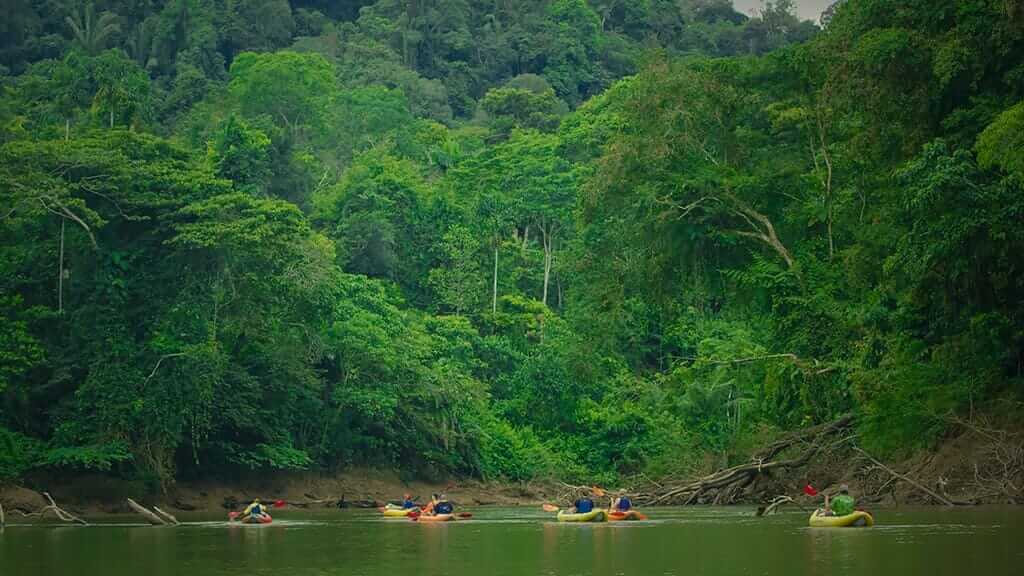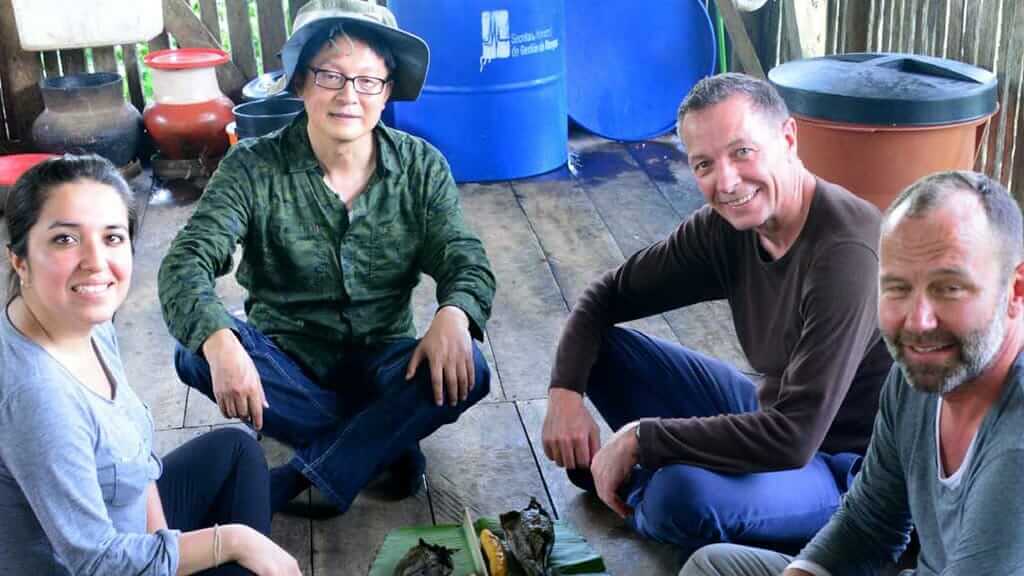Traveling to the Amazon rainforest is an Ecuador jungle vacation that inspires. The natural surroundings of places like Sacha Lodge, Sani Lodge, and Napo Wildlife Center completely overwhelms the senses. Finding your way along small river ways teaming with wildlife is an exotic adventure that takes one off guard. For those that want to experience a place where the people, the wildlife, and the environment all have a part in the day to day life where the modern world takes a step back, here is the Amazon Rainforest Travel Guide, to use as a reference for what to expect.
Rainforest trips to the jungle are made for adventure. From the moment you get off the plane to the day that you return to the airport, you are stepping into a territory that defies definition.
The Basics
There are three gateways to the jungle in Ecuador-Coca, Tena, and Cuyabeno-each offering a different experience and all giving you a rainforest trip that puts you front row to a natural performance that takes the breath away.
Most choose to fly to Coca and Cuyabeno while getting to Tena is easiest done by private transport. All are short trips-Ecuador’s size makes it easy to get from one destination to another.
For all three destinations, once you arrive at the main transport hub, you will be traveling by a combination of motorized and paddle canoe for the duration of your trip unless you to take one of the rainforest tours by cruise boat.
While there are different lodges in each region of the Amazon, many share common stops on their day trips. Parrot licks, lagoons, and observation towers find you with other intrepid travelers staying at nearby accommodations.
The Weather
Like the Galapagos Islands, the jungle has a wet and a dry season. Also like the islands, where the wildlife depends on the weather.
March, April, May, and June have the most rain in the Ecuador Amazon Basin. July through December is considered the dry season. In contrast with other regions of the country, the difference between the two is the amount of rain each day, not the fact that it has stopped completely. If you consider that it rains on average 200 days a year, you should have an idea of what to expect.
The heat and humidity is another thing to keep in mind. It can get hot-over a 100 degrees F in the dry season, but on average year round it is about 77 F.
The Wildlife
It’s pretty hard to go to the jungle and not to see wildlife almost everywhere you look. The birdlife is amazing, the mammals swing or hang from the trees, and reptiles, snakes, and insects are found every day or night when out with guides.
It’s more a matter of where you see the wildlife. During the dry season when the waters of tributaries, lagoons, and rivers recede, animals come out from under the thick protection of the canopy to find substance at the water’s edge. During the wet season, some species can be a bit harder to spot.
Activities
If you are staying at a jungle lodge like Tapir Lodge in Cuyabeno or Yarina Lodge downriver from Coca, you can expect early starts to catch the wildlife before the heat or rain set in. Canoe trips and hikes take you far off outposts and areas of the jungle where local guides and communities show you the wonders of their homeland.
Afternoons and evenings bring other excursions. Some places like Sacha Lodge have a swimming area on the lake it sits on where you can take a dip, or visit the nearby butterfly house where you can learn about the 40 species of butterflies that they have raised and studied since opening.
Other activities include fishing for piranha, visiting local communities, and night hikes and canoe rides to discover the nocturnal creatures of the regions.
How Long to Go
For the jungle, budgeting time is just as important as budgeting money. Consider the fact that two days are normally spent traveling, and that most of the time that this means a few hours in canoes and in airplanes-it starts to become clear that four and five-day trips give you’re the most bang for your buck.
There is a lot to see and do, and giving yourselves the time to explore and relax after big days under epic skies doesn’t skimp on the experience.
The Lodges
Each day amid the wildlife and learning about the communities that live in the Oriente deepened the connection to my surroundings and those that lived there.
I have been to two lodges in Ecuador, Napo Wildlife Center and Sani Lodge. Both are run by indigenous communities. Both are special places that need to be experienced in order to fully understand the beauty and adventure that has inspired people to travel in a rugged land for centuries.
There are around 800 species of birds living in the jungle. Toucans and macaws fly overhead when traveling down waterways by canoe. Mammals include jaguars, peccaries, and 19 species of monkeys-heard howling in the distance and seen in packs traversing the treetops.
These moments come out of the blue, making every day an adventure that finds you high up on observation towers, fishing for piranha in peaceful lagoons, and talking in hushed whispers to avoid scaring the animals.
The Sani and the Kichwa Añangu communities have lived in the jungle for generations-combining tradition, tourism, and a different way of life into fantastic experiences for all ages of travelers.
Sani was spearheaded by an energetic man named Don Orlando Gualinga. After working for oil companies for years, and seeing the mess that they left behind, Orlando turned the tables. For two years he lobbied the same oil companies that he worked for to help fund the eco-lodge.
The staff and guides at Sani are all members of the community. To work there, people are required to finish college, a requirement that brings young, talented people back to the jungle-something rarely seen before eco-tourism took hold.
The story of the Napo Wildlife Center has similar roots, a desire to preserve the natural diversity drove the members of the Añangu community to build an eco-lodge out of a storybook. Sitting on the edge of a stunning lagoon, the center is one of the success stories of the jungle.
Community tourism has funded schools, a health clinic, and cultural and conservation projects. All of the people who work at NWC are from the community, trained by experts who stepped aside once the place was up and running to an exacting degree of professionalism.
Seeing the passion of both communities is humbling. Their spirit and love of life are contagious-one can’t help but care for the environment, its creatures, and their stewards once the day is done.
Other Considerations
Even at luxury lodges like Napo Wildlife Center and La Selva, expect a different style of accommodation than found in more developed areas of the world. Lodges use natural materials that blend in with the surroundings, making places and spaces where open-air dining, porches with hammocks, and mosquito nets are chic ways to spend your time at the end of the day.
While some locations offer WiFi-often a pay as you go arrangement-don’t expect to keep in touch reliably with the world at large. Speeds are slow, and service can be spotty.
Keeping an open mind on trips in the jungle is one of the most important aspects to make the most out of your trip. Many lodges like Tapir Lodge in Cuyabeno and the Napo Wildlife Center work with local indigenous communities to forge a path forward for the people of the jungle. Many guides are members of these communities and have made great strides toward creating sustainable eco-lodges that offer services that incorporate their traditions. While not your usual places, they have hidden in plain sight charms that make the trip worthwhile.
What’s on your wishlist for traveling in Ecuador? What interests you the most about visiting? The culture, the people, the wildlife, the food?
Check out our video to learn more about our Amazon Rainforest tours with our sales team member David Bravo, who shares expert insights on everything from wildlife spotting and luxury lodges to indigenous culture, and how to choose the best region for your Amazon adventure
For more information about travel in the jungle of Ecuador and your options that include jungle cruises, Amazon kayak trips, and visiting communities as part of your trip, contact a member of our team by clicking here.









